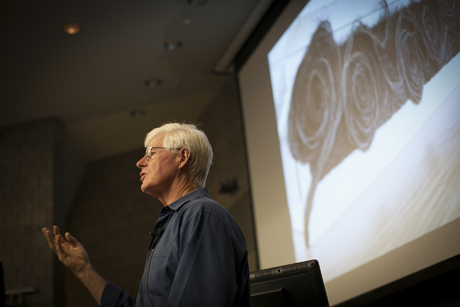Artist tells how he found his calling with 'stickwork'
By Scott Goldberg

“Stickwork artist” Patrick Dougherty once questioned what it meant to be a true artist. “Somehow you were supposed to be talented. I knew what the word art had to do with Michelangelo and Leonardo da Vinci,” Dougherty said Oct. 23 on campus. “I just couldn’t figure out what it had to do with me.”
Now years into his sculpting career, Dougherty reflected on his past in a Messenger lecture titled “Stickwork” as part of the University Course, The Art of Horticulture. Dougherty is on campus this week speaking in various venues.
After earning an undergraduate degree in English and graduate degrees in public health and in art history, Dougherty said that he was unsure how to use his passion for crafting things, so he turned to clay. Unsatisfied with the inflexibility of clay sculpting, he began working with sticks and tree saplings.
At first, he said that he was unsure of himself. “It’s difficult to maintain a sense of personal equilibrium in a society that gives high marks to culture but really ignores individual makers,” he said.
Now, 240 plant-based sculptures later, Dougherty said that he correlates artistic success with self-confidence. “I began to see what I liked and didn’t like,” he said. “Over a period of time, I began to develop my own sense of personal aesthetic.”
Dougherty said that he realizes that the art community is ever-growing and that it can seem daunting to compete with other artists. “In the last census, over a million people in New York City alone claim to be visual artists,” Dougherty said.
To combat the anxiety of competing, Dougherty said that it was essential to surround himself with other artists. “I didn’t know that there were other people like me. It wasn’t until I saw these relatively normal people who were compelled about making things that I realized there was going to be some hope for me,” he said.
In the end his message was clear: “I love to make things, so I just decided that the art world was going to have to lump it.”
In addition to recounting his personal story, Dougherty presented works of his that he had constructed across the country and in Europe and Asia. Using minimal tools and a well-honed technique to bend natural materials, Dougherty, with the help of volunteers, interweaves and fastens sticks and tree saplings together to create an intricately woven network of materials that evoke images of nests, igloos, urns, cocoons, cones, castles and beehives.
“I make temporary work that I build on-site from materials that I gather somewhere nearby,” said Dougherty. “I’m out there in public view, and the public sees the good and the bad of it.”
As a Cornell Council for the Arts artist-in-residence in 2006, Dougherty created a complex array of structures that resembled primordial huts in Collegetown. The installation remained in place for one year and was Collegetown’s first outdoor art project. Dougherty has won numerous awards, and his art is chronicled in a book, “Stickwork.”
While on campus, he also presented talks on the value of engaging with plants and art, and on public art and public space, and will lead a hands-on workshop at the Ithaca Children’s Garden.
Scott Goldberg ’16 is a writer intern for the Cornell Chronicle.
Media Contact
Get Cornell news delivered right to your inbox.
Subscribe